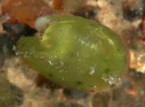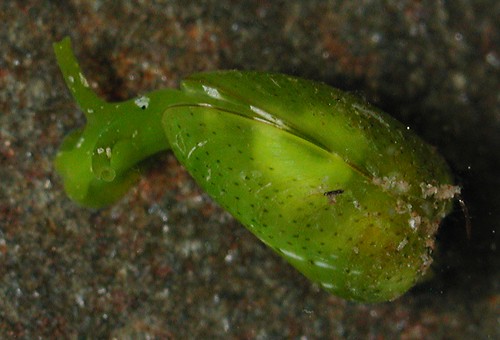| Home |
| Acknowledgments |
| Conventions |
| Glossary |
| Maps |
| References |
| Links |
| Articles |
| Thumbnails |
| Species
list |
| Family |
| Next
species |
Additional Photos

side of head

brown

young, 1.4 mm

shell

egg masses
_______________
GALLERY

Julia exquisita (Gould, 1862)

| Maximum size: 7.2 mm
(extrapolated from shell length). Identification: This species has a green to greenish-brown shell marked by radiating rows of green or brown spots that increase in number with age. The larger spots are associated with "comet tails" of cloudy white. The hinge tooth is proportionately larger and more oval than in Julia zebra but smaller than in Julia sp. #2. The animals are green, sometimes frosted with brown, and flecked with white. There are usually irregular white patches between the eye spots and at the midpoint of each rhinophore. Several broad bands of white show through the weekly translucent shell along the hinge line. Rarely, the green or brown spots on the shell may be lacking. (Note 1) Natural history: Julia exquisita is a common (though rarely seen) diurnal species found in moderately protected to exposed rocky habitats. It occurs at depths of < 1 to 5 m (< 3 to 16 ft). Bright green animals predominate at the shallower end of the range while brownish animals predominate at the deeper end. (Note 2) According to Kawaguti and Yamasu (1966), it feeds on Caulerpa ambigua and spawns on Microdictyon (as Julia japonica). (Note 3) Alison Kay also found it in association with Microdictyon on Kauai in 1962. (Kay, 1962c) It lays an irregularly cylindrical orange egg mass that hatches in about eight days in the laboratory. Distribution: Big Island, Maui, Oahu, Kauai, French Frigate Shoals, Laysan and Midway (also Johnston Atoll?): widely distributed in the Indo-Pacific. Taxonomic notes: Julia japonica Kuroda & Habe, 1951 may be a synonym of this species. Live animals were first recorded in Hawaii from Koloa, Kauai by Allison Kay on Feb. 2, 1962. (Kay, 1962b) The first shell material was reported in Gould, 1862. In southern Japan, the number of rows of radiating spots appears to be much more variable than in Hawaii. However, the absence of a "butterfly-shaped" marking on the hinge in live animals and the larger hinge size in shells still appear to distinguish those animals from J. zebra. Photo: CP: green; 4.8 mm: Hekili Point, Maui; March 23, 2007. Observations and comments: Note 1: Shells of this species show moderately strong red fluorescence under ultraviolet light (395 nM), most prominently when worn. Note 2: There's some possibility that the bright green and brown forms might be different species. However, a bright green and a brown animal held together spawned and produced fertile eggs after 14 days in isolation. Although some sacoglossids may retain sperm for such periods, this observation provides some support for lumping them. In addition, the underlying pattern of white pigment, as well as shell morphology, are identical in the two forms. Perhaps, the association of different colors with specific depths reflects a difference in diet? Note 3: Although it's found widely in habitats with mixed algal turf, we haven't found this species in association with any particular species of Caulerpa in Hawaii. Also, the various species of Caulerpa seem too patchy in distribution for any single one (or combination?) to account for the distribution of Julia exquisita. Perhaps, the Hawaiian population has a somewhat broader diet? |
| Thumbnails |
Species
list |
Family | Next species | Top |